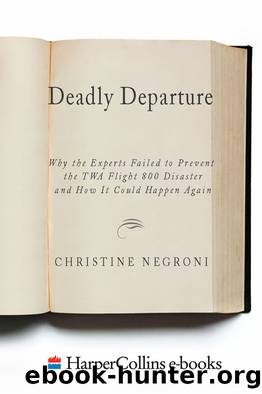Deadly Departure by Christine Negroni

Author:Christine Negroni
Language: eng
Format: epub
Publisher: HarperCollins
15
Of the eight men flying Air National Guard aircraft with the 106th Rescue Wing on the night of the crash of TWA Flight 800, only two had participated in actual wartime rescues. Dennis Richardson, fifty, and Frederick âFritzâ Meyer, fifty-six, had both served in Vietnam. An air force sergeant, Richardson had received three Distinguished Flying Crosses and three Air Medals. He also won a Purple Heart trying unsuccessfully to rescue a fighter pilot downed in North Vietnam in 1967. His HH-3E twin-engine helicopter had been chased off under heavy gunfire while attempting the rescue, and Richardson was shot in the arm.
After the crash of Flight 800, Richardson reflected on the difference between what he did as a soldier in the 1960s and the things he saw that night. âIn âNam, itâs a war. If youâre going to fly a rescue helicopter in Vietnam, you know some of us arenât going to make it back. But that night, there were so many bodies in the water, kids and some with not all of their arms and legs, there was nothing we could do for any of them. There was no one left alive.â
Not far from where Richardson was putting his life on the line in 1967, Fritz Meyer, a navy lieutenant, was piloting similar daredevil search-and-rescue missions in North Vietnam. His unit was supporting a navy helicopter assault squadron along the Mekong River. âI remember my first mission in the area, it was flying body bags out. It was a horror story,â Meyer recalled. âI made plenty of pickups in hostile territory, but no one who ever flew with me was ever injured, and my aircraft was never damaged from gunfire,â he reported proudly years later.
Like Richardson, Meyer earned military decorations: a Distinguished Flying Cross, six Air Medals, and a commendation from the Secretary of the Navy. The experience and prowess displayed by Meyer and Richardson during the conflict in Southeast Asia served the National Guardâs 106th Air Rescue Wing well.
âThatâs what we do, combat search and rescue, and that might include getting shot at,â explains Major Mike Noyes, a Pave Hawk helicopter pilot who was supervisor of flying at the 106th the night of the crash. âIt takes an amazing individual to do that.â
Meyerâs experience was one reason his eyewitness account was so highly regarded. If any weekend warrior knew what a missile looked like, it was Meyer. It explains why, as his story evolved during the next ten days, it became the cornerstone for many theories that a missile took down TWA Flight 800.
Richardson was also familiar with missiles. âIâve seen plenty of missiles. They used to shoot past us on their way to the big airplanes. They leave a big, smoky trail.â On the night of the crash, Richardson didnât see anything until copilot Chris Baur called his attention to a burst of light. By the time Richardson maneuvered to a view out the front window, a tremendous explosion had already lit up the sky. He did not see what preceded it, and he did not see the smoky contrail remains of a missile.
Download
This site does not store any files on its server. We only index and link to content provided by other sites. Please contact the content providers to delete copyright contents if any and email us, we'll remove relevant links or contents immediately.
| Automotive | Engineering |
| Transportation |
Small Unmanned Fixed-wing Aircraft Design by Andrew J. Keane Andras Sobester James P. Scanlan & András Sóbester & James P. Scanlan(32684)
Navigation and Map Reading by K Andrew(4963)
Endurance: Shackleton's Incredible Voyage by Alfred Lansing(4628)
And the Band Played On by Randy Shilts(2082)
Wild Ride by Adam Lashinsky(1901)
Top 10 Prague (EYEWITNESS TOP 10 TRAVEL GUIDES) by DK(1899)
The Box by Marc Levinson(1898)
The Race for Hitler's X-Planes: Britain's 1945 Mission to Capture Secret Luftwaffe Technology by John Christopher(1766)
The One Percenter Encyclopedia by Bill Hayes(1754)
Trans-Siberian Railway by Lonely Planet(1664)
Girls Auto Clinic Glove Box Guide by Patrice Banks(1654)
Looking for a Ship by John McPhee(1608)
Batavia's Graveyard by Mike Dash(1585)
TWA 800 by Jack Cashill(1564)
Fighting Hitler's Jets: The Extraordinary Story of the American Airmen Who Beat the Luftwaffe and Defeated Nazi Germany by Robert F. Dorr(1544)
Good with Words by Patrick Barry(1540)
Troubleshooting and Repair of Diesel Engines by Paul Dempsey(1531)
Ticket to Ride by Tom Chesshyre(1522)
Bligh by Rob Mundle(1519)
